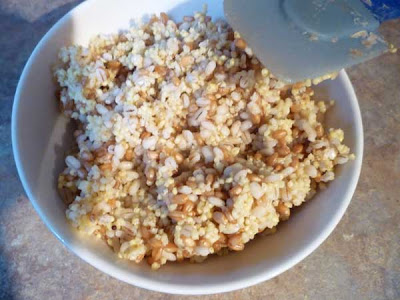A No-Knead Rye Sourdough with Boiled Whole Grains
I have been making a lot of pan loaves following the CIA guide for sourdough, mostly to use up my sourdough discards, and I have been quite happy with the taste, overall. This has become my new 'everyday bread', it would seem. I have made variations of it before:
- No Knead Rye & Whole Wheat loaves
- Revisiting that No Knead Rye & Whole Wheat Loaves recipe
- No Knead Sourdough breads - the latest iteration
- More Spent Sourdough Rye and Whole Wheat Breads
Lots of grains gathered
The rye dough is mixed prior to adding the grains
The grains to be added to the dough
The last time I put some whole grains into this recipe, it occurred to me that there is an infinite number of grain combinations that one might try, to enhance these loaves. Today I wanted a rye loaf, but I just serendipitously added a few grains that I just had at at hand -- those grains that were closest to the top of my grain bins. So I've added 1/4 cup each of wheat berries, millet and pearled barley to my rye sourdough, to see what might happen. I boiled the combined grains (total 148g) with double the amount of water (296g) until the water was absorbed or boiled away (about 15 minutes). I waited until it cooled to lukewarm before adding it to my sourdough mixture.
The only other change I've made to the recipe is, this time I did not paint the top with yogurt. I did spritz with a bit of water and put some sesame seeds on, but that is all. The result was a rich, dark, almost pumpernickel-coloured crust, a result of rye starches in the Maillard reaction, covering a nice bread-spice scented dense and heavy loaf.
Before Bulk Fermentation
After Bulk Fermentation
Docked with a fork, spritzed, and covered with sesame seeds
The Loaf fresh from the oven
The texture of the few grains that I put in this bread are merely enough to make you pause when eating a slice, allowing the mouth to add lots of amylase for digestion. And so by slowing down mastication we aid the entire digestive process.
The taste is wonderfully nutty, a rich taste; the dark acrylamides on the crust give it an interesting and complimentary bitterness, almost as if the grains have been roasted. This wouldn't be to everyone's taste, but I like it.
Unfortunately, the slices do not hold together well, and it is somewhat difficult to slice thinly. Furthermore, despite the long times that were used in baking, and the hot temperatures, the knife still does not come out clean, indicating that the center is not fully baked.
Notes to Myself
- Ingredients:
- Rye Starter 92.7% (373g)
- Rye Flour 100% (402g; 122g was dark rye, 280g light rye)
- Yeast 1% (4g)
- Salt 1.5% (6g)
- Water 85.4% (343g)
- Homemade Bread Spice 5g
- Boiled Seeds and Grains: Wheat, Millet and Pearled Barley 148g total, or 1/4c each
- Water to boil the seeds: 296g, or double the weight of the grains
- Method:
- Boil the seeds until the water is absorbed or boiled away. Let them cool until lukewarm.
- Mix all the ingredients together with your hands and pour into a greased pan.
- Let rise until about doubled. In my excalibur it took about 1 1/4 hours at 85 degrees F
- Bake at 450 degrees F for 65 minutes, then 15 minutes out of the tin in a cooling oven
- The loaf needs to be deeply docked, with a toothpick, do not use a fork. Make sure the toothpick or pin you use is moistened. Do put something on the crust so it doesn't burn: yogurt or egg wash, or perhaps a starch wash of some sort -- to protect it from the very hot and long temperatures that are surely needed to bake the center properly. Try scoring it once, too, to see if it will prevent the cracking that occurs in the top when baking. Try soaking the seeds that you put on top overnight before baking.
















No comments:
Post a Comment